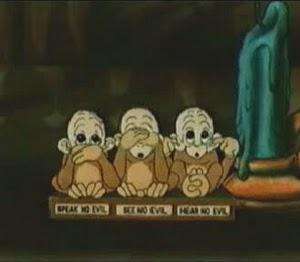Good Little Monkeys
See no evil, hear no evil, speak no evil, no!
Speak no evil, see no evil, hear no evil, no!
We're the Goody-Goody Monkeys every place we go.
Never have we gone astray,
Don't believe in being gay,[1]
Being good's the only thing we know; so,
Speak no hi-de, see no hi-de, hear no hi-de-ho![2]
Not a single wild oat will we sow!
We're so very very good, wouldn't be bad if we could,—The Opening Song
Good Little Monkeys was the tenth cartoon short in the Metro Goldwyn Mayer Happy Harmonies series produced (and in this case directed) by Hugh Harman and Rudolf Ising. It starred the Monkey Morality Pose simians of the title and their unforgettable theme-song. The short, which premiered on April 13, 1935, followed the then common pattern of various inanimate objects, such as toys, ornaments, advertisements, or book illustrations, coming to life and frolicking while no humans are around.
Synopsis
Out of a copy of Dante's Inferno comes a red devil, creeping up on the Goody Goody Monkeys, who sing of their unshakable morals. The devil rings a gong, to summon various book characters, etc., to make merry, and invites the monkeys to join the fun; they indignantly refuse, until he begins to tempt them with peanuts -- to a Latin rhythm. The monkeys follow the peanut trail, until the devil summons a scantily clad belly-dancer, to the prudish primates' horror. As the fiend attempts to seize the monkeys, all the other characters join together to rescue them; the devil dives back into the Inferno, and all cheer as the monkeys resume their places.
The cartoon was popular enough to inspire two sequels: the first, "Pipe Dreams" (February 5, 1938), featuring the monkeys smoking their way into nicotine visions, and the second, "Art Gallery" (May 13, 1939), having the monkeys induced by the statue of the Emperor Nero to get drunk on lighter fluid (!) and burn down the gallery's painted "Rome" -- and most of the other paintings besides.
- Animated Music Video: Pretty much the point of the whole Harman-Ising series.
- Art Evolution: The monkeys are redesigned in the later shorts to look distinctly cuter, with a much more child-like appearance (and sound).
- Barbie Doll Anatomy: Satan from the first short is completely naked with no dirty parts in sight.
- Breaking the Fourth Wall:
- Catchphrase Interruptus: From "Pipe Dreams":
Hobo Cigar: Who are ya, anyhow?
Monkeys: *simultaneous deep breath* We're the goody-goody monkeys everywhere we go . . .
Hobo Cigar: Yeah? What's so good about bein' good?
- In "Art Gallery", Nero interrupts the monkey's theme song, and sings a portion of it in a mocking tone. He is then joined by several portraits who each sing a portion of the song.
- Cerebus Syndrome: In the original short, the devil tries to lure the monkeys into the inferno, but they are saved by all of the storybook characters and the devil is chased back into his book. In "Pipe Dreams", the monkeys smoke a pipe and have a wild nightmare involving dancing cigars and Mexican cigarettes. "Art Galley" has the monkeys helping Nero burn a portrait of Rome, destroying most of the portraits and statues in the process.
- Everything's Better with Monkeys
- Evil Sounds Deep: The devil, complete with Evil Laugh ("Hahahahahahahaaaaaa -- and haaa!")
- Good Smoking, Evil Smoking: In "Pipe Dreams" the Monkeys' visions are implied to be the result of underaged smoking. (Since these visions are actually rather entertaining, this may seem something of a Broken Aesop.)
- Indecipherable Lyrics: What are The Three Musketeers singing in the middle portion of the song in "Good Little Monkeys"?
- Mickey Mousing
- Monkey Morality Pose
- No Celebrities Were Harmed: One of The Three Cigars in "Pipe Dreams" is based on Ned Sparks, a dour cigar-chomping character actor of the 1930s; in "Art Gallery," Cleopatra is Mae West, a Puritan is Ned Sparks, "The Song of the Lark" is popular portly singer Kate Smith, "Maestro" is conductor Leopold Stokowski, "Mammoth Cave" is comedian Joe E. Brown, "The Town Crier" is columnist Alexander Woolcott, the man whose collar is burned off is Herbert Hoover, and "Spirit of '76" is The Marx Brothers.
- Rotoscoping: Used on the nautch girl in "Good Little Monkeys"
- Satan: A story version of him is the villain of the first short.
- Shaggy Dog Story: "Art Gallery".
- Terrible Trio: The Three Cigars in Pipe Dreams"
